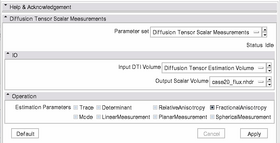Difference between revisions of "Modules:DiffusionTensorScalarMeasurements-Documentation-3.4"
(New page: Return to Slicer 3.4 Documentation __NOTOC__ ===Module Name=== MyModule {| |thumb|280px|Caption 1 |[[Image:screenshotBlank.png|thumb|28...) |
|||
| (2 intermediate revisions by 2 users not shown) | |||
| Line 1: | Line 1: | ||
[[Documentation-3.4|Return to Slicer 3.4 Documentation]] | [[Documentation-3.4|Return to Slicer 3.4 Documentation]] | ||
| + | |||
| + | [[Announcements:Slicer3.4#Highlights|Gallery of New Features]] | ||
__NOTOC__ | __NOTOC__ | ||
===Module Name=== | ===Module Name=== | ||
| Line 5: | Line 7: | ||
{| | {| | ||
| − | |[[Image: | + | |[[Image:DiffusionTensorScalarMeasurementsGUI.png|thumb|280px|Caption 1]] |
| − | |||
| − | |||
|} | |} | ||
| Line 13: | Line 13: | ||
===Module Type & Category=== | ===Module Type & Category=== | ||
| − | Type: | + | Type: CLI |
| − | Category: | + | Category: Diffusion Tensor |
===Authors, Collaborators & Contact=== | ===Authors, Collaborators & Contact=== | ||
| − | * Author1: | + | * Author1: Raúl San José Estépar, BWH |
| − | * | + | * Contact: [http://lmi.bwh.harvard.edu/~rjosest/address.html] |
| − | |||
| − | |||
===Module Description=== | ===Module Description=== | ||
| − | + | This module computes scalar measurement from Diffusion Tensor Image (DTI) Volumes. Those scalar measurements are meant to represent properties of the Tensor like anisotropy or apparent diffusion. | |
== Usage == | == Usage == | ||
| Line 30: | Line 28: | ||
===Examples, Use Cases & Tutorials=== | ===Examples, Use Cases & Tutorials=== | ||
| − | * | + | * Extract quantitative measurements of diffusivity from DTI volumes. |
| − | |||
| − | |||
===Quick Tour of Features and Use=== | ===Quick Tour of Features and Use=== | ||
| Line 60: | Line 56: | ||
===Source code & documentation=== | ===Source code & documentation=== | ||
| − | + | [http://www.na-mic.org/ViewVC/index.cgi/ Source code] | |
| − | |||
| − | |||
| + | [http://www.na-mic.org/Slicer/Documentation/Slicer3-doc/html/ Links] to documentation generated by doxygen. | ||
== More Information == | == More Information == | ||
Latest revision as of 22:12, 15 January 2010
Home < Modules:DiffusionTensorScalarMeasurements-Documentation-3.4Return to Slicer 3.4 Documentation
Module Name
MyModule
General Information
Module Type & Category
Type: CLI
Category: Diffusion Tensor
Authors, Collaborators & Contact
- Author1: Raúl San José Estépar, BWH
- Contact: [1]
Module Description
This module computes scalar measurement from Diffusion Tensor Image (DTI) Volumes. Those scalar measurements are meant to represent properties of the Tensor like anisotropy or apparent diffusion.
Usage
Examples, Use Cases & Tutorials
- Extract quantitative measurements of diffusivity from DTI volumes.
Quick Tour of Features and Use
List all the panels in your interface, their features, what they mean, and how to use them. For instance:
- Input panel:
- Parameters panel:
- Output panel:
- Viewing panel:
Development
Dependencies
Other modules or packages that are required for this module's use.
Known bugs
Follow this link to the Slicer3 bug tracker.
Usability issues
Follow this link to the Slicer3 bug tracker. Please select the usability issue category when browsing or contributing.
Source code & documentation
Links to documentation generated by doxygen.
More Information
Acknowledgment
Include funding and other support here.
References
Publications related to this module go here. Links to pdfs would be useful.
